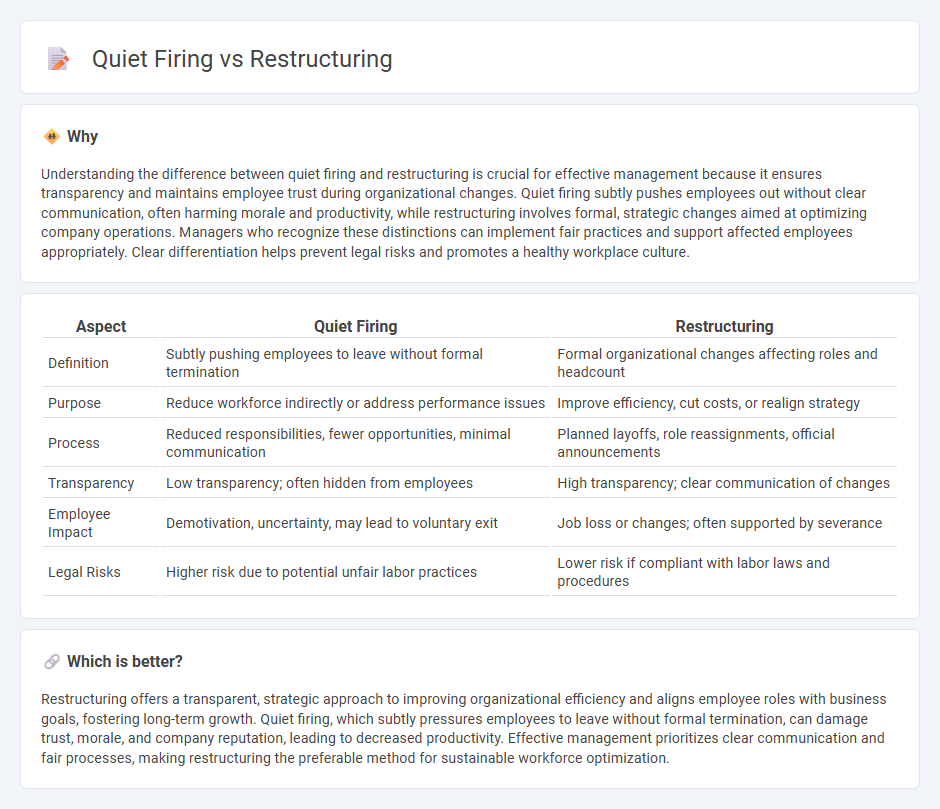
Quiet firing involves employers subtly encouraging employees to leave by reducing responsibilities or opportunities, impacting morale and retention. Restructuring entails formal organizational changes to improve efficiency, often involving role realignments or layoffs. Explore the differences and implications of quiet firing versus restructuring to understand their effects on workforce management.
Why it is important
Understanding the difference between quiet firing and restructuring is crucial for effective management because it ensures transparency and maintains employee trust during organizational changes. Quiet firing subtly pushes employees out without clear communication, often harming morale and productivity, while restructuring involves formal, strategic changes aimed at optimizing company operations. Managers who recognize these distinctions can implement fair practices and support affected employees appropriately. Clear differentiation helps prevent legal risks and promotes a healthy workplace culture.
Comparison Table
| Aspect | Quiet Firing | Restructuring |
|---|---|---|
| Definition | Subtly pushing employees to leave without formal termination | Formal organizational changes affecting roles and headcount |
| Purpose | Reduce workforce indirectly or address performance issues | Improve efficiency, cut costs, or realign strategy |
| Process | Reduced responsibilities, fewer opportunities, minimal communication | Planned layoffs, role reassignments, official announcements |
| Transparency | Low transparency; often hidden from employees | High transparency; clear communication of changes |
| Employee Impact | Demotivation, uncertainty, may lead to voluntary exit | Job loss or changes; often supported by severance |
| Legal Risks | Higher risk due to potential unfair labor practices | Lower risk if compliant with labor laws and procedures |
Which is better?
Restructuring offers a transparent, strategic approach to improving organizational efficiency and aligns employee roles with business goals, fostering long-term growth. Quiet firing, which subtly pressures employees to leave without formal termination, can damage trust, morale, and company reputation, leading to decreased productivity. Effective management prioritizes clear communication and fair processes, making restructuring the preferable method for sustainable workforce optimization.
Connection
Quiet firing often leads to restructuring as companies strategically reduce personnel without overt layoffs, impacting organizational workflows and team dynamics. Restructuring involves reconfiguring roles and processes, which can be driven by quiet firing practices aimed at performance management or cost reduction. Both approaches influence workforce morale and necessitate careful management to balance operational efficiency with employee engagement.
Key Terms
Organizational Change
Organizational change often involves restructuring, a deliberate process aimed at improving efficiency, reallocating resources, and aligning teams with strategic goals. Quiet firing, by contrast, is a subtle form of employee disengagement where essential responsibilities are reduced or opportunities are withheld, leading to voluntary departure without formal termination. Explore the differences between restructuring and quiet firing to enhance your change management strategies and workplace culture.
Workforce Reduction
Workforce reduction through restructuring involves strategic organizational changes aimed at improving efficiency by eliminating redundant roles, often accompanied by clear communication and severance packages. Quiet firing, in contrast, subtly pushes employees out by diminishing responsibilities and limiting opportunities without formal termination, causing disengagement and turnover without overt layoffs. Explore in-depth strategies and impacts of workforce reduction to optimize talent management effectively.
Performance Management
Restructuring involves formal organizational changes aimed at improving efficiency, often including workforce adjustments, whereas quiet firing refers to subtle management tactics that pressure underperforming employees to leave without explicit termination. Performance Management plays a crucial role in both scenarios by setting clear expectations, providing feedback, and documenting outcomes to support fair decision-making. Explore effective Performance Management strategies to navigate restructuring and prevent quiet firing practices.
Source and External Links
Restructuring - Wikipedia - Restructuring or Reframing is a corporate management process involving the reorganization of a company's legal, ownership, operational, or other structures.
What Is Corporate Restructuring? - This guide explores corporate restructuring as a process of reconfiguring a company's hierarchy, internal structure, or operations procedures to achieve specific goals.
Corporate Restructuring Strategies - Corporate restructuring involves reorganizing a company's management, finances, and operations to improve efficiency, often through mergers, acquisitions, or divestitures.
 dowidth.com
dowidth.com